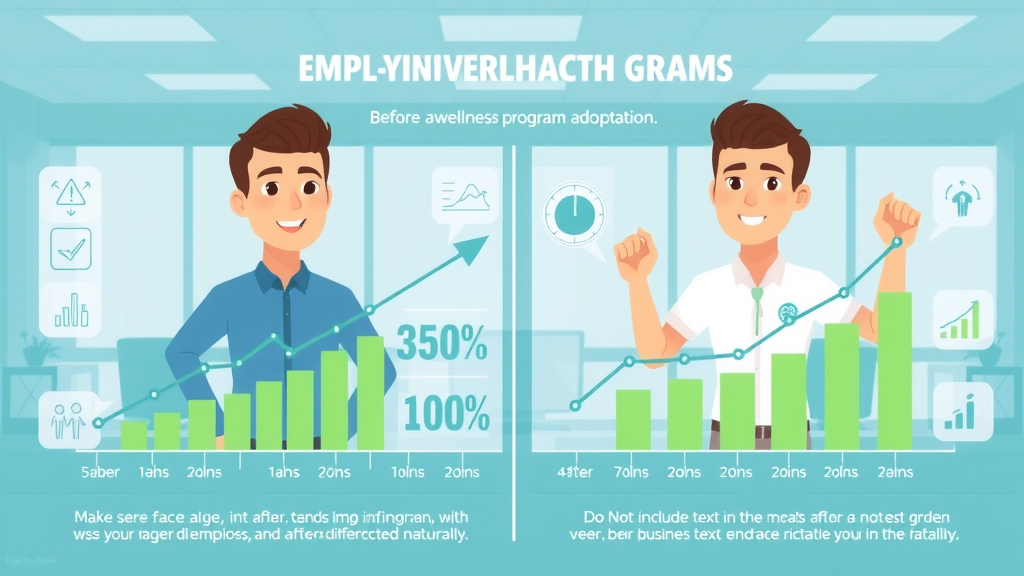Did you know that more than 70% of employers in the United States report a positive return on investment (ROI) from wellness program benefits? This figure isn’t just a number—it’s a wake-up call for CEOs and HR managers looking to spark real change within their organizations. In a world where care costs and workplace wellness are growing priorities, understanding the true power of employee wellness programs is not optional; it’s essential. Ready to uncover how wellness programs can fuel productivity, slash health plan costs, and boost morale? Let’s explore the benefits that could transform your business landscape.

Unlocking Wellness Program Benefits: A Game-Changer for CEOs and HR Managers
When it comes to reshaping your organization, wellness program benefits stand out as one of the most high-impact investments CEOs and HR professionals can make. Today’s competitive business environment demands more than the status quo; it requires a thriving workforce deeply engaged in both their well-being and job performance. Forward-thinking leaders are increasingly recognizing that employee wellness is not just a “nice to have”—it’s a strategic imperative. Wellness programs reduce health risks, foster healthier behaviors, and are proven to lower care costs. In fact, companies implementing effective wellness initiatives routinely see improvements in productivity, retention, and overall employee satisfaction. As workplace wellness becomes a benchmark for organizational health, the most successful businesses are those that integrate robust wellness program benefits focused on holistic support—physical activity, mental health resources, biometric screening, and incentives tailored to diverse needs. This commitment directly responds to rising care costs, changing health plan requirements, and the need for resilient employees ready to drive business goals.
Adopting employee wellness programs opens doors to measurable outcomes that extend far beyond simple health improvements. Businesses that prioritize workplace wellness foster a culture of engagement and innovation, enhancing their position in the marketplace. As we discuss the core wellness program benefits, you’ll see that every investment in health and wellness at work quickly becomes a catalyst for bottom-line results and a more inspired, loyal team.
A Surprising Truth: Over 70% of Employers Report Positive ROI from Wellness Program Benefits
According to recent studies, more than 70% of employers nationwide experience positive returns through their wellness program benefits—and this ROI isn’t limited to reduced care costs. Companies see lower absenteeism, increased healthy behavior among employees, and substantial improvements in productivity, engagement, and retention. These findings demonstrate that workplace wellness initiatives are more than compliance checklists or trendy benefits; they’re critical investments that reshape organizational culture and performance. Leveraging employee wellness programs has also been shown to decrease the prevalence of chronic disease and minimize risks associated with high-cost health care, especially when supported by health plan incentives and regular screenings. By establishing clear objectives and measuring success, HR managers and CEOs can tailor their approach for sustainable impact and ongoing improvement.
"Investing in wellness program benefits is investing in the future of your workforce."
What You'll Learn: Maximizing Wellness Program Benefits for Your Organization
Key wellness program benefits for modern businesses
How wellness programs enhance workplace wellness culture
The impact of employee wellness programs on productivity and engagement
Strategies to reduce health plan costs with wellness initiatives
Real-world insights from industry leaders
Understanding Wellness Program Benefits: An Essential Overview

Defining Wellness Programs and Their Role in Workplace Wellness
Wellness programs are comprehensive strategies designed to promote employee health by encouraging healthy behavior, providing preventive care, and supporting mental and physical well-being. For many organizations, these programs are integrated with health plans and often include services such as biometric screening, stress management, physical activity sessions, healthy meals, and educational workshops. The role of wellness programs in the workplace is to create a culture of care, helping organizations reduce health risks, minimize chronic disease, and lower overall care costs for both employees and employers. As a result, CEOs and HR managers find that investing in wellness program benefits leads to tangible returns: healthier, happier employees are more engaged and present, which translates into measurable improvements in business outcomes.
By focusing on physical activity, healthy behaviors, and access to high-quality wellness services, organizations can decrease health risks and empower their teams toward a healthy life. In the United States, government and official websites—such as the CDC and National Institute of Health—actively promote employee wellness programs as an effective approach to managing long-term care costs, boosting morale, and maintaining productivity even during disruptive times. Whether through structured health screening, access to healthy meals, or mental health support, wellness programs are proving vital to sustaining high-performing organizations.
Core Components of Employee Wellness Programs

The most effective employee wellness programs are comprised of several key elements: biometric screening to assess health status, physical activity opportunities, healthy meal initiatives, and resources supporting mental health. Other core components often include incentives for healthy behavior—such as health plan discounts, reduced insurance premiums, or rewards for meeting wellness milestones. These programs may also incorporate group activities (like walking challenges), access to confidential counseling services, flu vaccination drives, and educational sessions on topics such as heart disease prevention or stress management. When these components are customized to an organization’s unique needs and aligned with broader workplace wellness goals, the results are powerful: reduced absenteeism, better employee benefit offerings, and improved staff retention.
For modern businesses—regardless of size—wellness services need to be accessible, motivating, and inclusive. By providing a broad suite of wellness activities, leaders ensure employee participation and drive lasting change. From large corporations to smaller teams, the fundamental goal is consistent: to nurture a resilient, high-performing workforce that sees value in both health and company culture.
How Wellness Program Benefits Align With Health and Wellness Objectives
Successful wellness programs go beyond ticking boxes—they directly support health and wellness objectives by reducing employee health risks and chronic disease, increasing education about lifestyle choices, and making workplace wellness an intrinsic part of company culture. By incorporating measurable goals and clear health plan incentives, organizations are able to tailor wellness program benefits to address employees’ needs. This alignment improves outcomes for both the business and its people by fostering better engagement with health programs, lowering care costs, and reducing absenteeism linked to poor employee health.
When companies actively track employee participation and monitor changes in health risk factors, the impact of workplace wellness programs becomes clear: employees become healthier and more committed to their teams, while employers see improvements in productivity, morale, and retention. As the lines between personal and professional lives become more blurred, supporting health and wellness at work is no longer a bonus—it’s a vital business decision backed by data, experience, and a growing body of support from gov websites and health organizations.
Comprehensive List of Wellness Program Benefits
Improved employee health and wellness
Reduced healthcare costs and care costs
Enhanced productivity and workplace wellness
Lower rates of absenteeism
Increased engagement in healthy behaviors
Decreased risk of chronic disease
Better staff morale and retention

The Business Case for Workplace Wellness Programs: Measurable Outcomes
When reviewing the business case for wellness programs, it’s clear that companies with a health plan focused on wellness see marked reductions in health care costs, absenteeism, and improvements in overall productivity. Effective employee wellness initiatives can lower the risk of chronic diseases such as heart disease and diabetes, helping reduce claims and premiums for employer-sponsored health insurance. Real-world examples, both from the United States and abroad, prove that employers who invest in wellness program benefits ultimately see significant returns throughout their organization—including a positive cultural shift toward health and wellness and a marked drop in both direct and indirect costs related to employee health issues. The data below compares organizations with comprehensive employee wellness programs to those without, highlighting the compelling financial and operational gains associated with investing in workplace wellness.
Comparison of Wellness Program Benefits vs. No Wellness Programs | ||
Metric |
With Wellness Programs |
Without Wellness Programs |
|---|---|---|
Average Healthcare Costs per Employee (Annual) |
$8,200 |
$11,000 |
Absenteeism Rates |
1.8 days/month |
3.5 days/month |
Productivity Index |
85% |
72% |
How Employee Wellness Impacts Organizational Performance
Investing in employee wellness doesn’t just improve personal health—it transforms organizational performance from the inside out. When workplace wellness becomes a shared value, employees are more likely to practice healthy behaviors, embrace company initiatives, and feel invested in the future of their organization. Multiple studies report that companies with robust health and wellness programs enjoy lower turnover, greater productivity, and improved satisfaction scores—not just among employees but also in customer-facing roles. These effects ripple throughout the organization, boosting morale, collaboration, and innovation. With chronic disease and stress increasingly impacting today’s workforce, HR professionals can directly influence performance by embedding wellness program benefits into everyday culture and processes.
Empowered employees are more resilient, adaptable, and motivated, boosting business outcomes like customer loyalty and innovation. By leveraging health screenings, physical activity challenges, and mental health support, organizations create lasting engagement—turning individual wellness gains into a collective business advantage.
Quantifying Savings: Care Cost Reductions Through Wellness Programs
One of the strongest arguments for wellness program benefits is the measurable reduction in care costs for both employers and employees. For example, organizations leveraging wellness programs alongside existing health plans have been shown to decrease overall care cost burdens, thanks to earlier detection of health risks, prevention of chronic disease, and fewer claims for costly treatments. Consistent monitoring and data analysis reveal that savings often extend to ancillary metrics such as reduced absenteeism, fewer disability claims, and improved worker productivity. This is why many CEOs and HR leaders report not only savings on direct health care expenditures but also boosted employee morale and retention—critical factors as the cost of chronic illness and employee disengagement continue to climb nationwide.
"Our commitment to wellness programs has reduced our care costs by 23% in two years." – HR Director, Fortune 500 Company
Implementing Employee Wellness Programs: Strategies for Success
Designing a Targeted Employee Wellness Program

Creating an effective employee wellness program starts with understanding the specific needs and health risks of your workforce. The best strategies are built on data-driven insights—using health screening results, care cost analysis, and employee feedback—to shape tailored wellness solutions that drive engagement and participation. Include a mix of physical activity initiatives, healthy meals, and mental health resources to address a full range of wellness needs. Make participation easy and rewarding by integrating goals and incentives with existing health plan offerings and employee benefit systems. When HR managers collaborate proactively across departments, they can design inclusive wellness programs that foster participation from every demographic and role, ensuring both cultural and measurable impacts are achieved.
Successful implementation also relies on clear communication, supportive leadership, and ongoing evaluation—refining program elements based on engagement data, productivity gains, and employee health improvements over time.
Physical Activity and Healthy Behaviors: Driving Employee Engagement

Physical activity is the cornerstone of any impactful workplace wellness program, yet it’s only part of a broader approach to healthy behavior change. From on-site exercise classes and standing desk challenges to walking meetings and health risk competitions, variety encourages broader participation and supports sustained engagement. Modern wellness programs also focus on breaking down barriers to healthy behaviors—offering access to fitness equipment, counseling, and digital wellness services on demand. By embedding opportunities for healthy behaviors into daily routines, organizations see both short-term gains (in mood, alertness, and camaraderie) and long-term shifts in staff retention and job satisfaction. These active strategies foster a shared commitment to health, reinforcing the value of the company’s investment and energizing daily work culture.
Incorporating Health Plan Incentives within Wellness Programs
To maximize both engagement and ROI, many organizations are integrating health plan incentives with their wellness program benefits. Common benefits include health insurance premium discounts, contributions to HSAs (Health Savings Accounts), and direct rewards for completing health screenings or reaching physical activity benchmarks. Such incentives not only motivate healthy behaviors but also create transparency in care cost reduction goals, making employees feel actively involved in their own health and financial well-being. CEOs and HR managers are increasingly relying on these proven strategies—supported by secure website portals and mobile apps—to maintain high participation rates and adaptive program offerings. By linking personal achievement to tangible rewards and care cost savings, companies ensure both employees and their families see the value of ongoing wellness program engagement.
Best Practices for Sustainable Workplace Wellness
Sustainable workplace wellness programs are built on several foundational practices: ongoing employee education, regular measurement and reporting (including biometric screening and care cost metrics), leadership involvement, and flexible wellness services that adapt to evolving needs. HR leaders can further support program adoption by collecting employee feedback, celebrating milestone achievements publicly, and fostering an inclusive environment where every team member feels invited to participate—regardless of physical ability or current health status. Leveraging official website resources and partnering with trusted wellness service providers support both program credibility and participation, driving long-term value for all stakeholders involved.
Innovative Approaches to Wellness Programs
Technology-Enabled Employee Wellness Programs

As digital health technologies evolve, tech-enabled employee wellness programs are now more accessible and customizable than ever. From wearable fitness trackers measuring steps and heart rates to mobile apps providing real-time wellness coaching and access to secure health care resources, digital platforms are transforming the way organizations drive healthy behavior. For CEOs and HR teams, this means collecting more actionable data on employee health and wellness, streamlining scheduling, and offering personalized incentives that maximize engagement. Technology supports a continuous improvement cycle—delivering timely reminders, feedback, and motivation for employees to reach their physical activity and wellness goals every day, making data-driven wellness the new standard for business leaders seeking competitive, measurable outcomes.
Leveraging Data to Enhance Health and Wellness Outcomes
Modern wellness programs go beyond activity tracking by leveraging aggregate data to refine strategies, target high-need groups, and demonstrate ROI to executive teams. Dashboards, analytics, and secure website platforms make it easier than ever for HR professionals to track key metrics in care cost reduction, absenteeism, and healthy behavior adoption. Data-driven decisions allow organizations to continuously adapt, ensuring wellness initiatives remain aligned with evolving workforce needs and strategic business goals. Enhanced reporting capabilities also offer transparency for leadership, supporting the ongoing investment in workplace wellness initiatives and reinforcing the business case for comprehensive wellness program benefits.
PEOPLE ALSO ASK: What are the wellness program benefits?
Answer: Defining and Detailing the Top Wellness Program Benefits for Businesses

Wellness program benefits can profoundly impact a business’s bottom line and employee experience. Chief advantages include improved employee health outcomes, reduced care costs and health plan expenses, lower absenteeism, and higher productivity. Wellness programs often foster positive workplace wellness cultures, enhance morale, and encourage healthy behaviors and physical activity. For organizations looking to manage chronic disease risk, such initiatives provide effective early detection and tailored support, making it easier to offer competitive employee benefit packages and attract or retain top talent in a challenging market. The ripple effects—higher engagement, lower turnover, and a healthier business reputation—are just as valuable as the measurable financial savings.
PEOPLE ALSO ASK: What are the benefits of wellness health?
Answer: Exploring the Broad and Lasting Impact of Wellness Health on Organizations and Employees
Wellness health initiatives address both physical and mental aspects of employee well-being, empowering individuals to pursue a healthy life inside and outside of work. The most notable benefits for organizations include risk reduction for chronic illnesses, consistent improvement in overall workforce health, improved employee benefit satisfaction, and lower healthcare utilization over time. On an individual level, employees experience greater resilience, reduced stress, and sustainable healthy behaviors—supporting long-term engagement and minimizing costly disruptions for both parties. Evidence from official websites and health organizations across the United States confirms that investing in wellness health is a proactive business strategy with compounding value year after year.
PEOPLE ALSO ASK: Are wellness programs worth it?
Answer: Evaluating the ROI of Wellness Program Benefits and Long-term Organizational Value

For both small and large businesses, the evidence overwhelmingly shows that wellness programs are worth the investment. Beyond immediate reductions in care costs, organizations benefit from increased productivity, lower health care claims, and improved employee retention. By investing in health and wellness, leadership demonstrates a commitment to its people—fueling long-term growth, a positive workplace wellness culture, and a more robust employee wellness program offering. Numerous case studies and data from gov websites affirm that the sustainability and value of well-designed wellness programs far exceed their initial costs, producing a strong, positive ROI that extends throughout the organization’s life cycle.
PEOPLE ALSO ASK: What are the benefits of the Medicare wellness program?
Answer: Specific Wellness Program Benefits Offered Through Medicare and Their Business Implications
The Medicare wellness program provides beneficiaries—especially older employees and retirees—with preventive health services, including annual wellness visits, health risk assessments, and early screening for chronic disease. For organizations, promoting Medicare-aligned wellness initiatives supports employees in making informed decisions about their health care and reduces cost exposure associated with unmanaged health conditions. Business leaders find that encouraging participation in these official, gov website-backed services complements broader workplace wellness goals, fostering healthier, more independent workforces with reduced absenteeism and improved long-term outcomes for both individuals and employers.
FAQs: Everything CEOs and HR Managers Need to Know About Wellness Program Benefits
How do wellness programs affect employee retention? Wellness programs demonstrate an employer’s commitment to employee well-being, improving morale and loyalty. Studies show organizations with robust workplace wellness regimes enjoy lower turnover and greater satisfaction among team members.
What specific metrics should HR monitor to assess wellness program success? Key metrics include employee participation rates, changes in biometric screening outcomes, reductions in care cost and absenteeism, and improvements in productivity or satisfaction surveys. Tracking these data points over time can guide program refinement.
Can small businesses benefit equally from wellness program implementation? Absolutely. Scaled wellness solutions can fit even limited budgets and still provide positive ROI through fewer absences, improved engagement, and a healthier team environment.
What are common barriers to employee participation and how to overcome them? Challenges may include lack of awareness, time constraints, or program complexity. HR can overcome these by communicating frequently, offering flexible participation options, and integrating incentives to motivate engagement.
Conclusion: Leverage Wellness Program Benefits for Lasting Business Impact
"Prioritizing wellness program benefits isn't just good for employees—it’s a strategic decision for the business bottom line."
By proactively investing in wellness program benefits, CEOs and HR managers lay the groundwork for healthier, more productive organizations—transforming care cost challenges into opportunities for sustainable growth.
Key Takeaways: Making the Most of Wellness Program Benefits
Wellness program benefits drive productivity, reduce costs, and improve culture.
Measurable ROI can be achieved through thoughtful implementation.
Inclusive and data-driven wellness strategies yield lasting results.
Get Started Today: Call Me the Chaplain 786-333-5270 for Expert Guidance on Wellness Program Benefits
If you’re ready to take the next step in maximizing your organization’s wellness program benefits—whether for a new launch or a current initiative—reach out for tailored advice that makes a difference.
Sources
https://www.shrm.org/resourcesandtools/hr-topics/benefits/pages/wellness-programs-roi.aspx
https://www.nhlbi.nih.gov/health-topics/education-and-awareness/health-literacy
Implementing a comprehensive wellness program can significantly enhance your organization’s productivity and employee satisfaction. For instance, the article “6 Benefits of Employee Wellness Programs” by Quest Diagnostics outlines key advantages such as increased healthy behaviors, reduced healthcare costs, and improved productivity and engagement. (questdiagnostics.com) Similarly, “5 Major Benefits of Employee Wellness Programs” by Time Doctor emphasizes improved employee health behavior, reduced stress, and enhanced relationships among staff. (timedoctor.com) By exploring these resources, you can gain valuable insights into how wellness programs can transform your business landscape.
 Add Row
Add Row  Add
Add 




Write A Comment